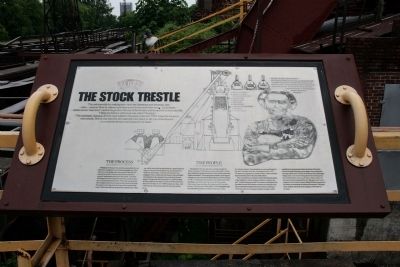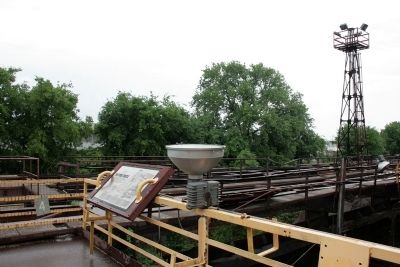Birmingham in Jefferson County, Alabama — The American South (East South Central)
The Stock Trestle
Sloss Furnaces National Historic Landmark
The raw materials for making iron—iron ore, limestone and dolomite, and coke—came to Sloss by railroad and were stored in the stock bins below. An inclined, steam-driven "skip hoist" carried the stock to the top of the furnace and dumped it in automatically. Filling the furnace with stock was called "charging." The automatic charging devices were added to the plant in the late 1920s when the furnaces were rebuilt. Before that time the raw materials were taken to the top of the furnace on a vertical elevator and dumped in by hand.
The Process
Charging the furnace was actually accomplished by ingenious arrangement of mechanical equipment. Railroad cars carrying the stock were pushed onto the elevated stock trestle. Doors in the bottom of the cars opened, releasing the stock into the bins below. The bins discharged the stock by gravity feed into a scale car that ran in a tunnel beneath the bins. The scale car automatically weighed each load of material and carried it through the tunnel to the skip pit at the base of the inclined skip hoist. There the scale car dropped the material into a skip car, which was pulled up the incline by a steam-powered hoist. At the top of the car tipped over and dumped the stock into the furnace. The top of the furnace was equipped with a double bell and hopper that permitted raw materials to be charged without allowing furnace gases to escape into the atmosphere. A typical charge at Sloss might be two skips of coke at 3100 pounds per skip and two skips of ore at 5000 pounds per skip, with 1500 pounds of limestone added to the second skip of ore.
The People
Inhaling blast furnace gas was a constant danger for those working at the furnaces, stoves, and boilers, for the gas contained a significant amount of the lethal compound carbon monoxide. The most famous fatality involving the inhalation of gas occurred at Birmingham's Alice Furnaces in 1887. Theophilus Calvin Jowers was killed there while installing a new bell in the top of one of the furnaces. Overcome by gas and heat, he tripped and fell into the furnace. The account of his death in the The Birmingham Age reported that his body was reduced almost to ashes.
According to legend, Jowers's ghost was seen and heard at the Alice Furnaces until they were abandoned in 1927. His ghost then apparently moved to Sloss, where over the years it became part of the city's folk culture.
The circumstances of Jowers's death illustrate the perils of gas inhalation. Some workers said they could see the gas, "a bluish-looking smoke," but other complained that gas leaks around the furnace occurred so frequently that they sometimes breathed the fumes before realizing it. Over the years, the company initiated stringent safety regulations to prevent gas related accidents. Men who worked in the areas where gas was a danger were required to wear gas masks and to notify the foreman when entering a danger zone. Any man working above the receiving hopper at the furnace's top not only had to wear a mask, but also had to be accompanied by two "get-away men" and a respirator. Even when workers followed these measures to the letter, an occasional accident still occurred. Although most workers survived such mishaps, a few were not so lucky.
Erected by Sloss Furnaces Historic Landmark.
Topics. This historical marker is listed in this topic list: Industry & Commerce.
Location. 33° 31.235′ N, 86° 47.444′ W. Marker is in Birmingham, Alabama, in Jefferson County. Marker can be reached from the intersection of 32nd Street North and 2nd Avenue North, on the left when traveling north. This marker is located on the grounds of the Sloss Furnaces National Historic Landmark. Touch for map. Marker is at or near this postal address: 20 32nd Street North, Birmingham AL 35222, United States of America. Touch for directions.
Other nearby markers. At least 8 other markers are within walking distance of this marker. Casting Pigs (here, next to this marker); The Blast Furnace (a few steps from this marker); Stock Trestle/Tunnel (a few steps from this marker); Slag (within shouting distance of this marker); The Gas System (within shouting distance of this marker); Racial Terrorism and Convict Leasing / Racial Violence at Brookside Mines (within shouting distance of this marker); Boilers (within shouting distance of this marker); Ironmaking (within shouting distance of this marker). Touch for a list and map of all markers in Birmingham.
More about this marker. This marker can be found just outside the Furnace Number 1's casting shed, south of the furnace.
Also see . . . Sloss Furnaces National Historic Landmark. (Submitted on October 7, 2013.)
Credits. This page was last revised on June 16, 2016. It was originally submitted on October 6, 2013, by Timothy Carr of Birmingham, Alabama. This page has been viewed 632 times since then and 21 times this year. Last updated on May 29, 2015, by J. Makali Bruton of Accra, Ghana. Photos: 1, 2. submitted on October 6, 2013, by Timothy Carr of Birmingham, Alabama. • Bill Pfingsten was the editor who published this page.

